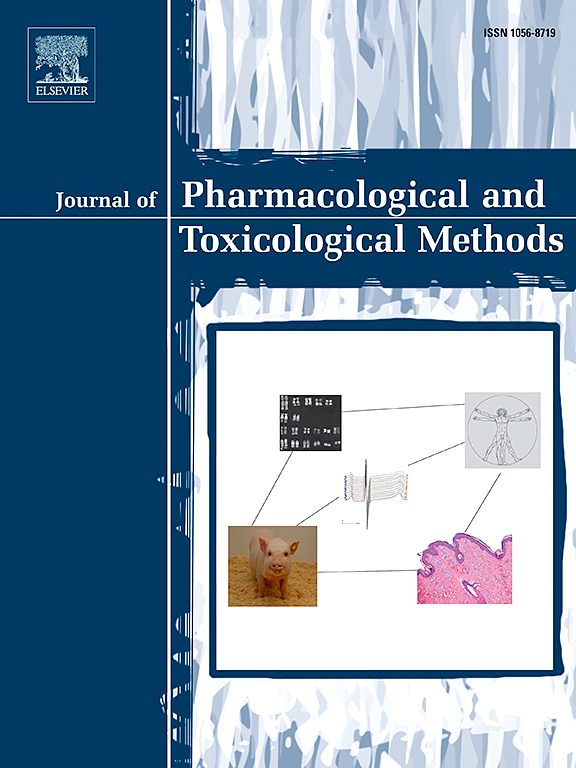计算模型的改进翻译心脏肌力和松弛药物的作用,从大鼠到人。
IF 1.3
4区 医学
Q4 PHARMACOLOGY & PHARMACY
Journal of pharmacological and toxicological methods
Pub Date : 2025-05-13
DOI:10.1016/j.vascn.2025.107747
引用次数: 0
摘要
遥测大鼠被广泛用于早期药物筛选,但大鼠和人类心脏之间明显的生理差异限制了翻译的相关性。为了解决这一问题,该研究调查了计算机建模的潜力,以改善从细胞尺度开始的肌力和弹力药物效应从大鼠到人类的转化。为此,构建了大鼠和人左心室心肌细胞的计算机模型来再现实验数据。首先,全局敏感性分析确定了大鼠和人类对离子通道和转运体抑制的肌力和松弛性反应的显著差异。然后,利用计算机模型根据从大鼠获得的肌节长度和细胞内[Ca2+]数据来预测人类的反应,从而解决翻译挑战。这一过程被称为计算药物效应翻译,涉及识别药物对潜在靶标的阻断能力。针对可识别的靶标RyR2、SERCA2和NCX1,对合成数据的评估显示,在所有生物标志物和药物浓度下,翻译精度都很高。例如,预测人体效应的决定系数为 ≥ 0.997,而大鼠对肌节缩短百分比的影响为≤0.771;从峰值到90 %松弛时间的决定系数为 ≥ 0.905,而≤0.418。对收集的thapsigargin实验数据的评估在很大程度上证实了这些发现。结果表明,计算机建模可以改善肌力和弹力药物效应从大鼠到人类的转化,为增加当前药物开发管道提供潜在的好处。本文章由计算机程序翻译,如有差异,请以英文原文为准。
Computational modelling for improved translation of cardiac inotropic and lusitropic drug effects from rats to humans
Telemetered rats are widely used for early drug screenings but pronounced physiological differences between rat and human hearts limit translational relevance. To address this, the study investigates the potential of computer modelling to improve the translation of inotropic and lusitropic drug effects from rats to humans, beginning at the cellular scale. To this end, computer models of rat and human left ventricular cardiomyocytes were constructed to reproduce experimental data. First, global sensitivity analyses identified distinctive differences in inotropic and lusitropic responses to the inhibition of ion channels and transporters in rats and humans. Then, the computer models were used to address the translation challenge by predicting human responses based on sarcomere length and intracellular [Ca2+] data obtained from rats. This process, referred to as computational drug effect translation, involved identifying the drug's blocking potencies on potential targets. Focussing on the identifiable targets RyR2, SERCA2, and NCX1, evaluations on synthetic data showed high translation accuracy across all biomarkers and drug concentrations. For example, coefficients of determination were ≥ 0.997 for predicted human effects compared to ≤0.771 for rat effects for percentage sarcomere shortening, and ≥ 0.905 compared to ≤0.418 for the time from peak to 90 % relaxation. Evaluations on experimental data collected for thapsigargin largely corroborated these findings. The results demonstrate that computer modelling can improve the translation of inotropic and lusitropic drug effects from rats to humans, offering potential benefits for augmenting the current drug development pipeline.
求助全文
通过发布文献求助,成功后即可免费获取论文全文。
去求助
来源期刊

Journal of pharmacological and toxicological methods
PHARMACOLOGY & PHARMACY-TOXICOLOGY
CiteScore
3.60
自引率
10.50%
发文量
56
审稿时长
26 days
期刊介绍:
Journal of Pharmacological and Toxicological Methods publishes original articles on current methods of investigation used in pharmacology and toxicology. Pharmacology and toxicology are defined in the broadest sense, referring to actions of drugs and chemicals on all living systems. With its international editorial board and noted contributors, Journal of Pharmacological and Toxicological Methods is the leading journal devoted exclusively to experimental procedures used by pharmacologists and toxicologists.
 求助内容:
求助内容: 应助结果提醒方式:
应助结果提醒方式:


